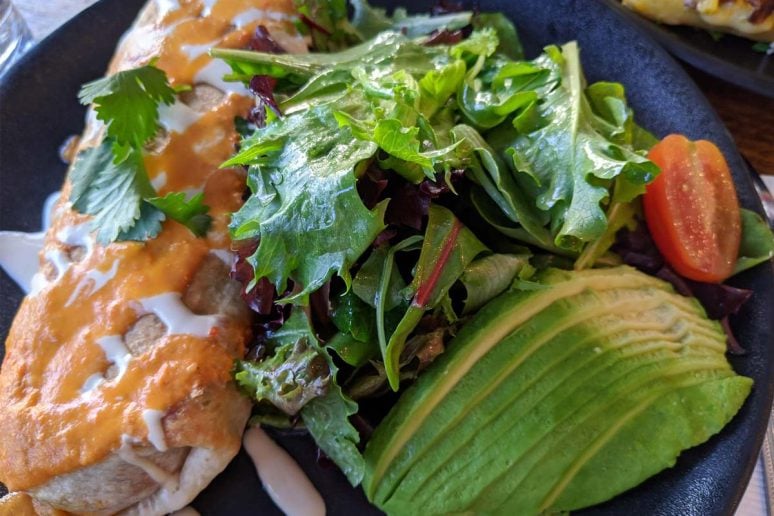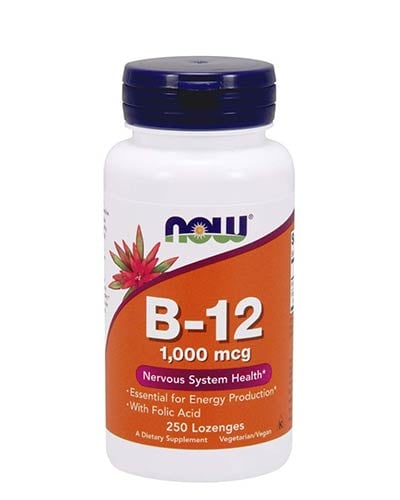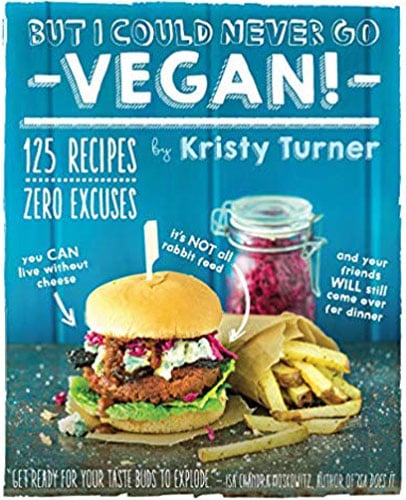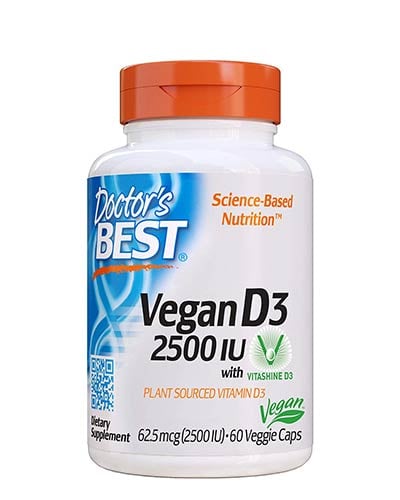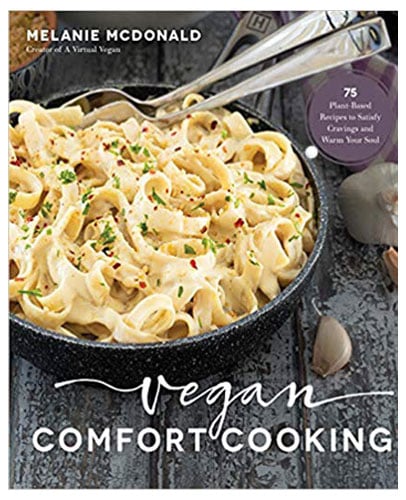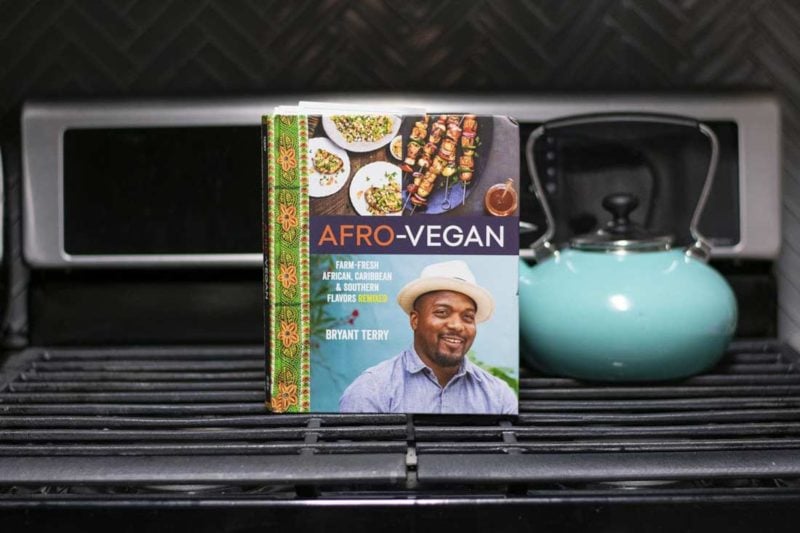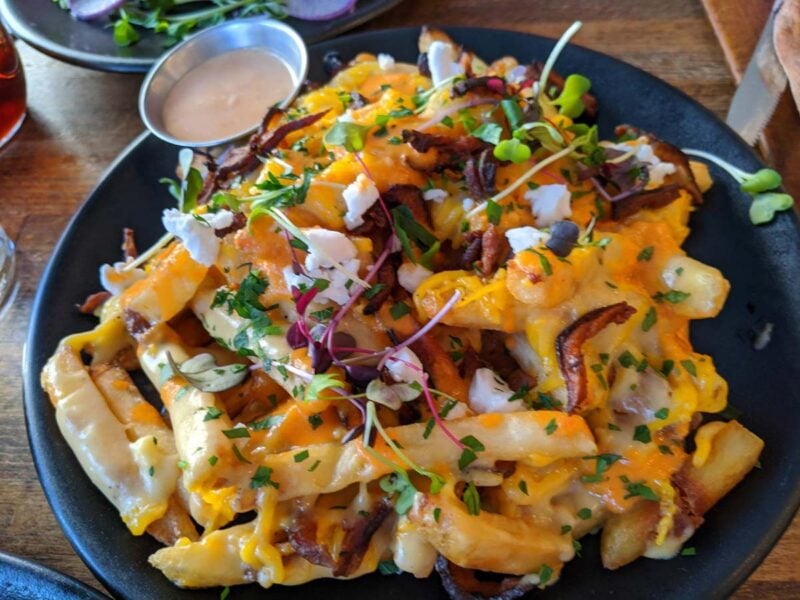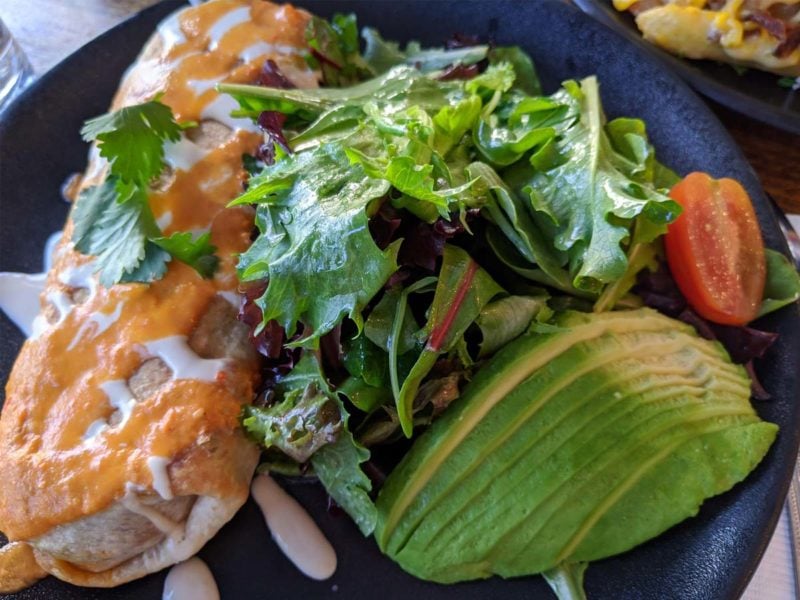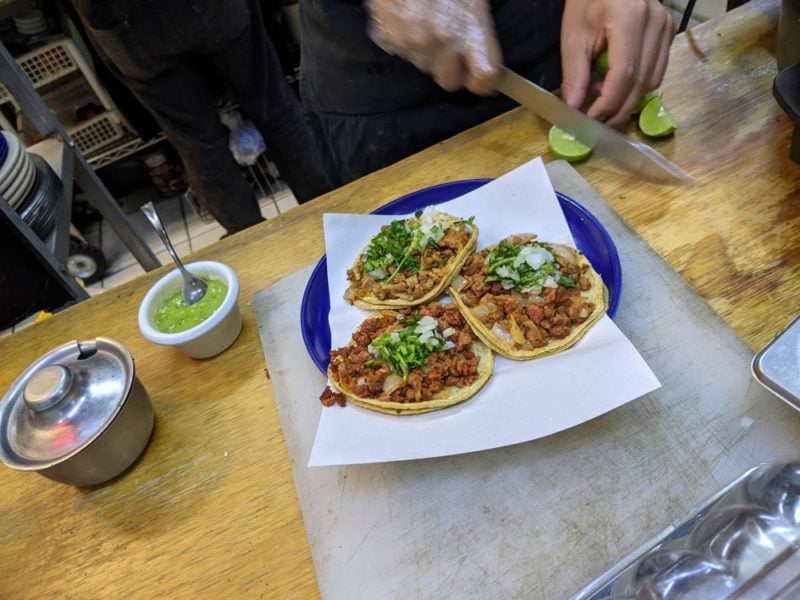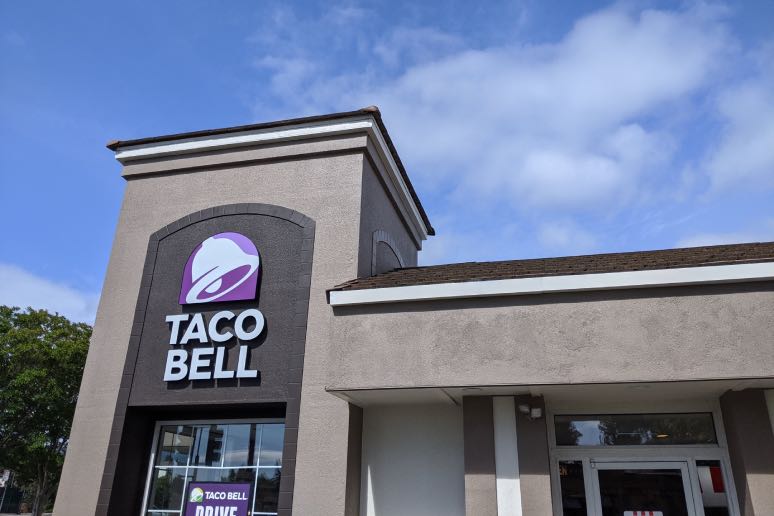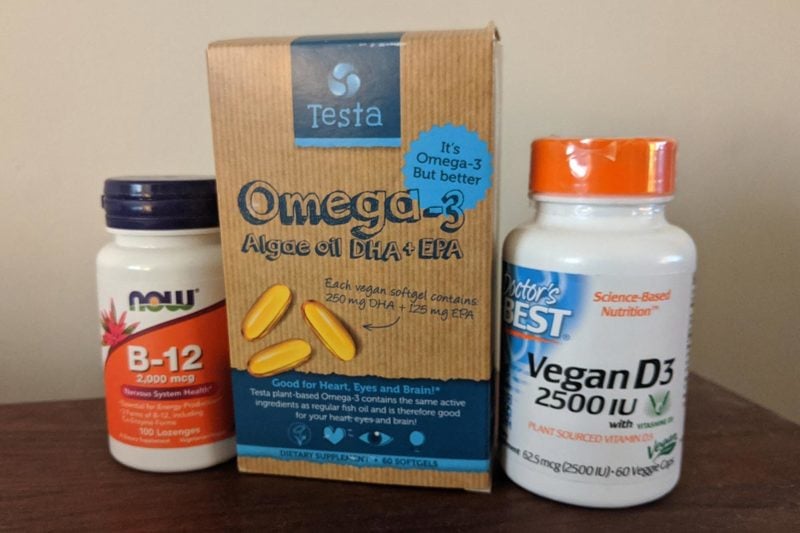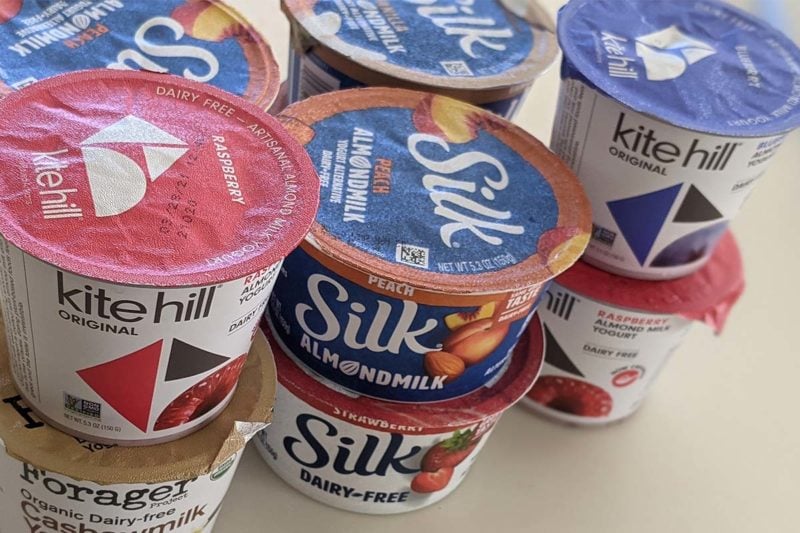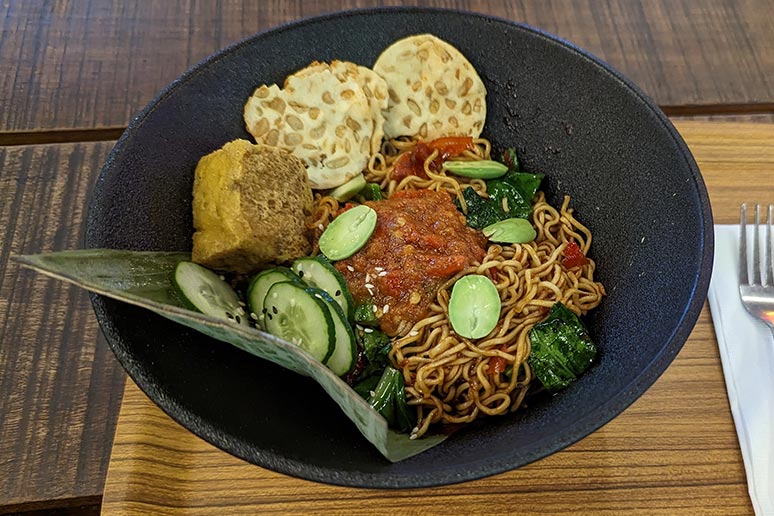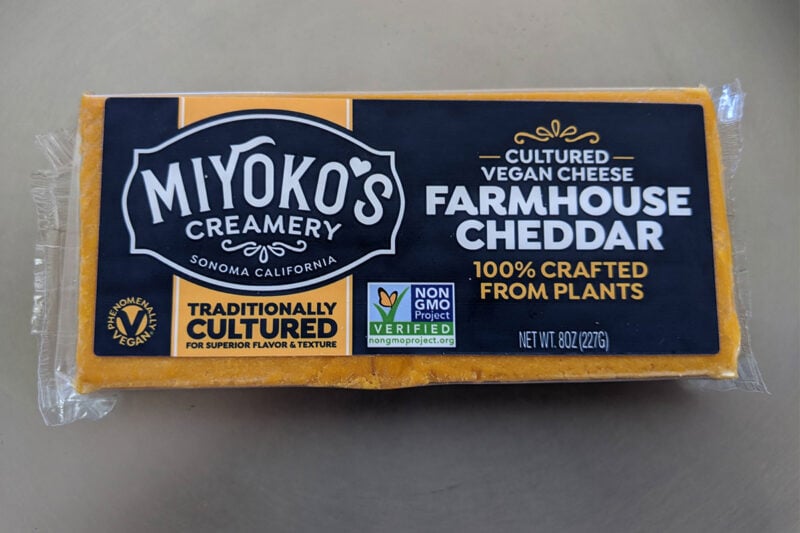This guide explains how to go vegan with minimal effort, in a lasting and healthy way. I’ve followed a vegan diet for more than thirty years, so I can offer tons of useful advice. By the time you finish reading, you’ll know exactly how to move forward.
Easy Ideas for Starting Out
You can go vegan all at once, or you can transition gradually over weeks or months. Either way, there are simple things you can do that will make moving in a vegan direction a lot easier. Here are some potent ideas that I’ll get into over the course of this article:
- Be vegan in your kitchen—resolve to never again bring animal products into your home.
- Read up on the basics of vegan cooking.
- Try out a vegan diet for a week or a month.
- Follow Mark Bittman’s Vegan Before 6 plan, and eat vegan each day until dinner.
- Stop eating any particular non-vegan foods you feel ready to quit.
- Explore the hundreds of vegan alternatives to meat, dairy, and egg-based foods.
- Commit to trying five new vegan foods every week.
I’ll explore these ideas in greater depth over the course of this article. But before we get into any of those things, let’s begin with this article’s #1 piece of advice.
Go Vegan by Crowding, Not Cutting
Go about things the wrong way, and your vegan transition will demand massive willpower and struggle. This happens when you cut a bunch of non-vegan foods out of your diet, without having anything ready to eat instead. You’ll end up trying replacements you don’t like, having non-fulfilling meals, and generally feeling dissatisfied with your new diet.
Or you can take the easy approach, which requires no sacrifice whatsoever.
Here’s all you need to do to have an enjoyable and effortless transition: don’t seek to cut animal products out of your diet—instead, crowd them out.
To make this happen, you want to try new vegan foods at every opportunity. Every time you discover a new vegan food you enjoy, it’ll crowd more non-vegan foods out of your diet. You’ll make rapid progress just by sampling new foods every time you get the chance.
A steady ongoing effort delivers huge payoffs. So, until you’re happily entrenched in a vegan lifestyle, never let a week go by without trying at least a few new vegan foods. I recommend committing to try five new vegan foods every week.
Discover the Endless Assortment of Incredible Vegan Foods
On your first day of kindergarten, they didn’t dump a calculus textbook on your desk. Beginnings should be easy. My list of easy vegan foods includes dozens of delicious items. Some are ready-to-eat, while others take just minutes to prepare. None require any cooking skills.
Once you’ve reviewed that list, my guide to vegan eating will introduce you to the best cooking, dining, and grocery shopping possibilities.
Next, you can check out some of these food-oriented links:
- Vegan Cooking Guide
- Vegan-Friendly Cuisines
- Grocery Items
- Vegan Restaurant Food
- Vegan Foods—My A-to-Z Roundup
- Cookbooks
- Vegan Alternatives to Meat, Dairy, and Egg-Based foods
Read all of the above pages and you’ll know more about vegan food than many vegans who’ve been at it a decade. You’ll be off to the strongest possible start to embracing a totally vegan diet.
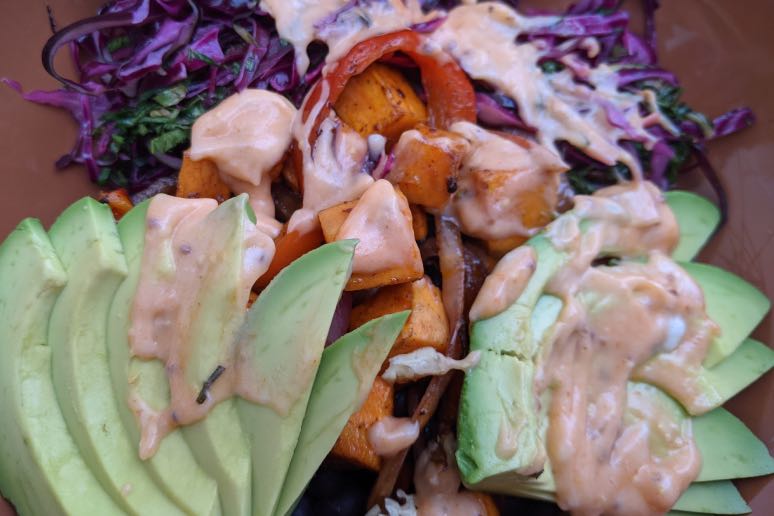
Stepping Stones Toward a Vegan Diet
How fast should you move towards a vegan diet? That’s totally up to you. The more new foods you try, the more quickly you will progress.
You certainly don’t need to go entirely vegan overnight. While some people do it all at once, others ease into a vegan diet over months or even years.
If you’re taking the gradual approach, use whichever ideas enable you to gain the most ground with the least effort. Here are three of the most helpful tactics for aspiring vegans:
1) Vegan Before Six
Mark Bittman is one of America’s most influential food writers. He has long followed a “Vegan Before 6:00” approach. That is, he eats a totally vegan diet from morning through late afternoon. Then, starting at dinner, and continuing for the rest of the evening, he eats whatever he wants—sometimes vegan foods, and sometimes non-vegetarian foods.
Bittman’s Vegan Before 6:00 approach offers perhaps the easiest way to become mostly vegan. By getting you in the habit of eating vegan most of the time, it’ll perfectly prepare you to throw the switch and become vegan after 6:00 PM too. To learn more, check out Bittman’s book on the topic.
2) Do a Vegan Test Drive
Does a lifelong commitment scare you? No worries—why not simply take a vegan diet for a test drive? Just try out a vegan diet for a week, 21 days, or an entire month. You’ll quickly see for yourself how well a plant-based lifestyle works for you.
Being vegan gets easier the longer you stick with it. It only takes a few weeks for vegan foods to become your default choice. By the time your test drive ends, you may well decide to keep going and stay vegan for good.
3) Go Vegan In Your Kitchen
In my first year of college, I randomly encountered a slaughterhouse video. Horrified by what I saw, I started dropping meat from my diet and quickly became vegetarian. During my junior year, I moved into a cottage off-campus and had my very own kitchen. I realized that my unfettered kitchen access offered the perfect opportunity to move from vegetarian to vegan. I resolved to never bring any non-vegan food into my new house.
Since I rarely ate out, my resolution to keep animal products out of my home instantly made me at least 90 percent vegan. Plus, this commitment pushed me to improve my vegan cooking skills. I found a collection of easy vegan recipes and I was off to the races.
Narrow Down Your Limitations
Keeping a vegan kitchen turned out to be the biggest step I took toward a vegan diet. The other crucial step was getting super ridiculously precise about my limits.
I found quitting meat easy. But dairy products were another matter. I had grown up eating tons of cheese, yogurt, and ice cream. As a result, the idea of going dairy-free terrified me. My thoughts on the topic amounted to:
I’m not yet ready to give up dairy products.
You can’t move far down the vegan path with such a broadly-worded limitation. So I asked myself: did I like all dairy products equally? On any given day, I might drink milk, eat ice cream, or put a slice of cheese on a sandwich. How did I feel about these foods?
The truth was that I never liked the taste of milk. On the other hand, I enjoyed ice cream but hardly ever craved it. So, I’d have an easy time ditching milk, while cutting out ice cream posed only a minor challenge. But quitting cheese was a whole other thing. I adored cheese. Realizing this, it made sense to narrow my above limitation to:
I’m not yet ready to give up cheese.
With that refinement of my original limitation, I’d made some real headway! What a difference there is between being unready to give up all dairy products, and simply being unready to give up cheese.
Keep Whittling Away at the Non-Vegan Foods in Your Life
A little reflection got me a long way. I was now ready to quit everything but cheese. But I wanted to go even further. So I next asked myself, “Do I love all cheese equally?”
A powerful question with an easy answer: absolutely not. I loved mozzarella cheese on pizzas. I enjoyed—but certainly never craved—Swiss cheese on sandwiches. Everybody knows processed American cheese slices are dreadful. And fancy French cheeses never appealed to me. With all this in mind, I decided that I could cheerfully give up cheese on everything except pizza.
Upon making that decision, my previous limitation surrounding cheese narrowed considerably:
I’m not yet ready to give up cheese pizzas.
I’d come so far. But I wasn’t done yet.
Have You Gotten as Specific as Possible?
I next thought about the cheese pizzas sold locally (I was attending college in Santa Cruz, California). My town had a Round Table pizza parlor, which I liked very much. I could also, I suppose, order pizza from Domino’s—which never rose above mediocre. Or, I could visit Pizza My Heart, a locally-owned pizzeria that served the most delicious slices I’d ever eaten. I decided that giving up Domino’s and Round Table posed no hardship as long as I could still enjoy the occasional slice from Pizza My Heart. So, my limitation was once again narrowed:
I am not yet ready to give up cheese pizza from Pizza My Heart.
As the months rolled by, I was discovering all sorts of vegan foods that tasted every bit as wonderful as the pies from Pizza My Heart. Before long, even Pizza My Heart’s slices lost their grip on me. I felt absolutely ready to take the plunge and go totally vegan. This decision felt anticlimactic because it entailed not the slightest sense of sacrifice.
Success at Last!
Thanks to my clearly defining which foods I felt ready to quit, dairy products did not conquer me; I conquered dairy products. I hope my pizza story inspires you to take the same approach to phasing out any non-vegan foods you particularly enjoy.
A happy postscript to my pizza story is that, thirty years later, Pizza My Heart finally got around to offering Miyoko’s vegan cheese on their pies. So, I’m now back to eating one of my very favorite foods whenever I visit Santa Cruz.
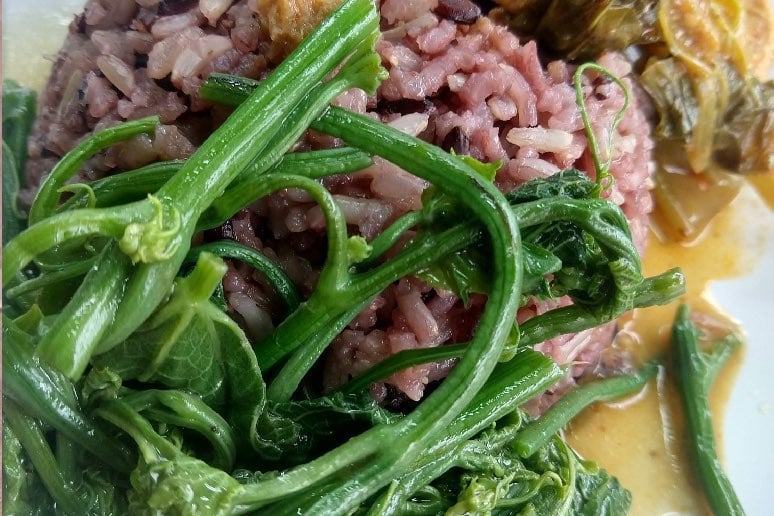
Vegan Books and Cookbooks
Now that I’ve shared my most important advice, let’s take a step back and come up with a sound overarching strategy towards becoming vegan.
Going vegan poses no overwhelming hardships. But a lasting transition does require changing the way you shop, cook, and dine out. You should also read up on nutrition. The remainder of this article explores all these topics.
Before we get to those things, let’s cover how to find the most reliable sources of vegan information, as well as how to get ahold of the best vegan cookbooks and recipes.
Don’t Believe Everything You Read
Any vegan-oriented book can motivate you to rid your diet of animal products. Unfortunately, these books are commonly filled with misinformation. Never assume that a book’s footnotes properly support its assertions. Likewise, don’t trust a book simply because its author has a medical degree. As with every other sort of diet, the vegan world includes a number of doctors who twist the facts to suit their biases.
Thanks to unreliable books, too many new vegans go from uninformed to misinformed—a step backward in the guise of a step forward! So if you want to read up on vegan topics, seek out trustworthy books. My recommended vegan books page features only the most credible titles.
Before you invest in vegan books, you might as well read the key reference content I’ve written on vegan topics. All this material is free, and it’s only a click away. These articles collectively amount to hundreds of pages and have taken me years to write. My vegan information page offers well-organized links to everything.
Shopping for Vegan Cookbooks
Vegan cooking offers endless possibilities. A well-chosen cookbook lets you explore whichever cooking niche most excites you. You can find vegan cookbooks covering every topic: Mexican food, breads, Instant Pot meals, desserts, and so forth.
Sadly, many vegan cookbooks are disappointing (Note 1). They often include untested recipes and feature little or no food photography. Don’t waste your money on inferior offerings. My vegan cookbooks page features all the best recent selections spanning every important cooking specialty.
Recommended Vegan Cookbooks
Choosing your very first vegan cookbook is an important decision. You need to pick a book that delivers one easy surefire winning recipe after another. At all costs, avoid titles that feature fussy or time-consuming recipes. What you want is a diverse collection of meals that take 20 minutes or less to prepare. Here are some perfect choices:
- Fast Easy Cheap Vegan, by Sam Turnbull
- Plants Only Kitchen, by Gaz Oakley
- The 30-Day Vegan Meal Plan for Beginners, by Garza & Pitts
- Vegan Buddha Bowls, by Cara Carin Cifelli
For more, see the “Easy Everyday Cookbooks” section of my vegan cookbooks page.
If all these exceptional titles leaves you paralyzed by choice, then use the Amazon.com “Look Inside” feature to see each cookbook’s table of contents. That will enable you to choose a title based on which recipes appeal to you most. If you’re still in doubt over which one to purchase, always favor cookbooks jam-packed with beautiful full-color photos.
Choosing Your Second Cookbook
Once you’ve purchased an easy cookbook for everyday cooking, consider next buying a large reference cookbook—the bigger the better. That way, anytime you crave a classic dish, whether it’s pancakes or lasagna, you’ll have a solid recipe ready to go. When it comes to giant vegan cookbooks, you can’t do better than Oh She Glows for Dinner. Or, if you want something truly encyclopedic, get ahold of Robin Robertson’s 1,000 Vegan Recipes. I normally don’t recommend cookbooks that lack food photos, but here I’ll make an exception—if you want an affordable world-class collection featuring every recipe under the sun, 1,000 Vegan Recipes has no rival.
And by all means explore your favorite cooking specialty. You can find vegan cookbooks devoted to every cuisine, including Italian, Indian, Thai, Mexican, and Ethiopian. Other exciting niche titles focus on Instant Pots, one-dish meals, whole-grain baking, and even homemade vegan cheese. Discover them all on my vegan cookbooks page.
Vegan Nutrition
A vegan diet can easily meet your body’s nutritional requirements. The Academy of Nutrition and Dietetics affirms vegans can satisfy their nutritional needs at every stage of life. That includes childhood, old age, and pregnancy. Millions of people thrive on plant-based diets. And a growing number of the world’s top athletes eat vegan too.
That said, some vegans exhibit alarming lapses in their knowledge of nutrition. Worse yet, indiscriminate reading can actually compound the problem since a number of popular vegan health books offer faulty nutrition guidance.
Easy Ways to Improve Your Diet
With so much bad advice finding its way into print, you must stay vigilant. Far better to read one book that’s accurate than three books that aren’t. Start by reading our free online Vegan Nutrition Guide, written by top expert Virginia Messina, MPH, RD. For a deeper dive, check out the outstanding book Messina coauthored, Vegan for Life.
Reading up on nutrition can inspire all sorts of healthy decisions. Among other benefits, you’ll identify the worst foods presently in your diet and learn how to swap in more sensible choices.
Here’s an easy shopping habit that has worked wonders for me. When I finish grocery shopping and am ready to hit the cash register, I glance over the contents of my grocery cart. I want to see it loaded up with plenty of fresh fruits and vegetables, plus healthy items from the bulk department. If I’ve come up short, I wheel my cart back to the produce section to set things right.
Eating plenty of vegetables and beans won’t by itself guarantee you’ve met all your nutritional needs. But these foods are far more nutritious than most other foods. Leafy greens in particular are especially nutrient dense, yet super low in calories. A handful of nuts or seeds each day will further boost your protein and mineral intake.
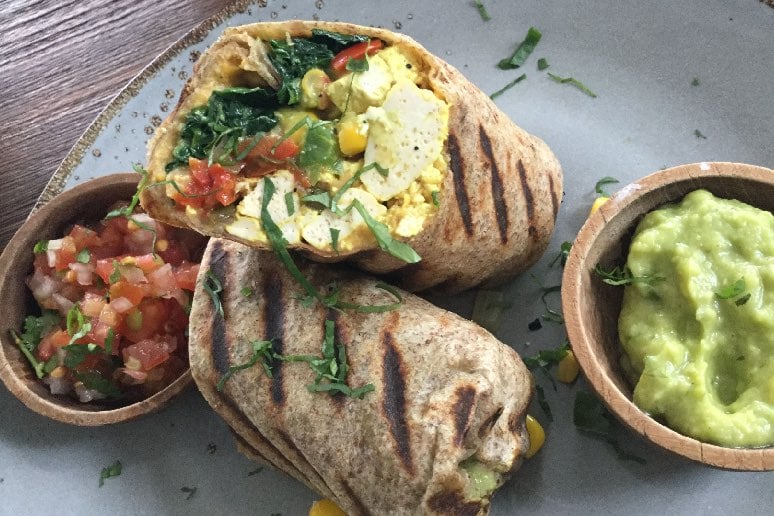
Do Vegans Need Supplements?
Since unfortified vegan foods don’t contain Vitamin B12, vegans and near-vegans must find a reliable source of this nutrient. No problem is more easily solved. Just take an inexpensive high-dose sublingual tablet every couple of days. Since I write daily, I keep my B12 bottle next to my laptop so I don’t forget to take it. You might keep your B12 next to your toothbrush or gym bag.
B12 deficiencies can bring dire and irreversible consequences, so don’t take chances. A good B12 supplement can satisfy your needs for an entire year for about $10.
Other nutrients deserving your attention include:
Our Vegan Vitamin Guide offers links to the best deals on all these supplements.
Vegan Grocery Shopping
Every new vegan should hone their grocery shopping skills. Keep your refrigerator and pantry properly stocked and you’ll have delicious vegan food on hand whenever you get hungry.
Let’s now review the basics of vegan grocery shopping.
Supermarkets & Natural Food Stores
Every supermarket carries a wide variety of vegan foods. These include:
- Beans
- Bread
- Rice
- Nuts & Seeds
- Hummus
- Vegan Milks
- Breakfast Cereal
- Pasta & Noodles
- Fruits
- Vegetables
- Chips & Crackers
With plant-based diets gaining popularity, most supermarkets carry an impressive selection of vegan foods. Some even operate a separate store-within-a-store devoted to natural foods. You will never go hungry.
That said, a good natural foods store provides an even better selection of vegan groceries. Plus, they often have lower prices on the foods you purchase most, since supermarkets rarely put their natural foods items on sale.
Quite a few natural food stores are overpriced and under-stocked. Some of these places are nothing more than glorified vitamin shops, offering little in the way of healthy and affordable food. Fortunately, you can easily gauge whether a natural food store deserves your business. Upon stepping inside, just compare the size of its produce section to its vitamins section. You’ll know at a glance if the store’s primary intention involves selling healthful foods. If the store mainly seeks to profit from high-margin supplements, you’ll see aisles of overpriced vitamins, but a minimal selection of fruits and vegetables.
Shopping at Natural Food Stores
The best natural food stores carry way more vegan foods than do supermarkets. They also commonly offer a much better produce department.
Plus, their bulk foods department can save you a fortune. Staples like rice, beans, nuts, and breakfast cereal cost considerably less when purchased in bulk. You will also find good deals on premium bulk items like coffee, seaweed, chocolate, and a wide assortment of spices.
Larger stores feature delis that offer a variety of interesting and convenient vegan foods. Try making the deli items you like best at home. They’re usually easy to make, and cheaply prepared from scratch.
Most natural food stores offer good prices on fruits, vegetables, and common pantry items. But prices on frozen vegan convenience foods are usually high. Frozen vegan pizzas and TV dinners can cost triple what you’d pay for their non-vegan counterparts at supermarkets. So, to reduce your food costs, avoid convenience foods. Instead, buy most of your foods from the bulk section and produce department.
Farmers’ Markets and CSAs
For the finest local produce, find out if a farmers’ market operates near you. Also check whether any nearby farms offer a CSA (Community Supported Agriculture) program. CSAs are the most effective way to support local agriculture, since they guarantee farmers income in advance of planting their crops.
LocalHarvest.org publishes directories of farmers’ markets and CSAs located across the United States. You probably have one closer than you think.
Farmers’ markets offer the freshest possible food. Crops are often harvested the same morning they’re sold. On top of that, shopping at farmers’ markets reduces your carbon footprint since your food is never trucked long distances.
By cutting out the middleman and minimizing transport costs, farmers markets and CSAs bring you superior food at low prices. They enable you to support small and sustainable farms, rather than industrial agriculture thousands of kilometers away. Local agriculture usually involves less petrochemical use and more fertile soils. My Ultimate Vegan Guide explores the appeal of farmers’ markets in greater detail, and you can also read my page about how to best shop for organic foods.
Specialty Groceries
Just about every medium-sized and large city has an assortment of ethnic grocery stores.
These places offer fantastic vegan foods unavailable anywhere else. Asian food markets sell ridiculously cheap tofu that is often delivered fresh each morning. They also carry a terrific assortment of mushrooms and shockingly inexpensive seaweed.
Indian grocery stores deserve a visit just for their papadums and jarred pickle relishes. And don’t miss the inexpensive freshly-made vegetable samosas and pakoras, usually kept warm under heat lamps.
Greek and Turkish markets offer hummus, dolmas, figs, and roasted peppers. They’ll invariably sell at least a dozen varieties of premium olives. And that’s just the start of all the premium vegan delicacies they offer.
If you live near a Trader Joe’s, you must pay it a visit. This grocery chain rose to fame by selling all sorts of delicious specialty foods at rock-bottom prices. A remarkably high percentage of their products are vegan. While the chain constantly adds and discontinues items, you can find all the latest vegan goodies on their website.
Ordering Vegan Foods Online
Don’t despair if your community lacks a good natural foods store—Amazon.com can pick up the slack. The site offers countless vegan foods, from energy bars to silken tofu to nutritional yeast.
Amazon doesn’t carry every single popular vegan grocery item, and its selection is minimal in several categories. But the site does offer low prices on many essentials. Our vegan grocery page lists Amazon’s best vegan food deals. Additionally, Amazon’s vitamin prices nearly always beat local retailers.
Vegan Alternatives to Meat, Dairy Products, and Eggs
How can you go vegan if you still crave the taste of meat, dairy products, or eggs?
Luckily, countless people before you have overcome this exact problem. Monks of a thousand years ago, quitting meat for spiritual reasons, turned to tofu, tempeh, and seitan—the low-tech meat replacements of their era. These delicious foods will fill you up just like meat, and they contain comparable amounts of protein too. But let’s be honest: they will never trick anyone into thinking they’re meat.
But then, do you really need to fool anybody? Nobody will ever mistake broiled tempeh doused with barbecue sauce for spare ribs, but so what? You won’t find a more delicious or satisfying dish. Same goes for stir-fried tofu, which you can spice and season a hundred different ways.
The New Generation of Vegan Alternatives
When the 1960s counterculture kicked off America’s first wave of vegetarianism, people experimenting with meat-free diets discovered the virtues of tofu, tempeh, and seitan. Vegetarians of that era also popularized nutritional yeast, a protein-rich food that delivers a delicious cheesy flavor. If you like cheese, try sprinkling nutritional yeast over everything from popcorn to salads to spaghetti.
By the 1990s, no longer could anyone dismiss vegetarianism as a fad. Exploding demand inspired alternatives to every major non-vegan food. These products tasted sufficiently delicious that even non-vegetarians bought them. This brought about a virtuous cycle: growing sales funded increased R&D, which in turn led to even tastier products.
Soon, top meat companies recognized the market for vegan meats had grown too big to ignore. JBS, Tyson, and Maple Leaf Foods spent heavily to develop vegan burgers and sausage. And fast food chains likewise began introducing vegan offerings.
Groceries and restaurants alike now offer an unprecedented assortment of vegan meat, egg, and dairy alternatives. These items deliver spectacular flavors, formerly unobtainable from vegan foods. Many of these offerings can fool even devout meat eaters. Whether it’s mayonnaise or chicken nuggets or ice cream, delicious vegan alternatives abound. For extensive coverage of all your options, see our Vegan Alternatives page.
Vegan Cooking Basics
Vegan cooking offers limitless possibilities. You will eat tastier and more nutritious food when you learn how to make it yourself. Plus, nobody knows your preferences better than you. Doing your own cooking lets you prepare food just the way you like it.
Cooking at home lets you work your favorite ingredients into the meals you eat most often. For instance, if you love cashew butter, eggplant, or red potatoes, you can gravitate towards recipes based on these ingredients. Or if you crave strong flavors like ginger, garlic, or onions, you can use these foods to your heart’s content.
The basics of vegan cooking take almost no time to learn. You don’t even need a vegan cookbook to get started—just read my vegan cooking guide. Some of the tastiest vegan recipes require just minutes to prepare. Check out these incredibly versatile yet super quick classics:
You can make each of the above foods in countless delicious variations. Just a little time spent learning to prepare these meals will set you up for a lifetime of healthy eating.
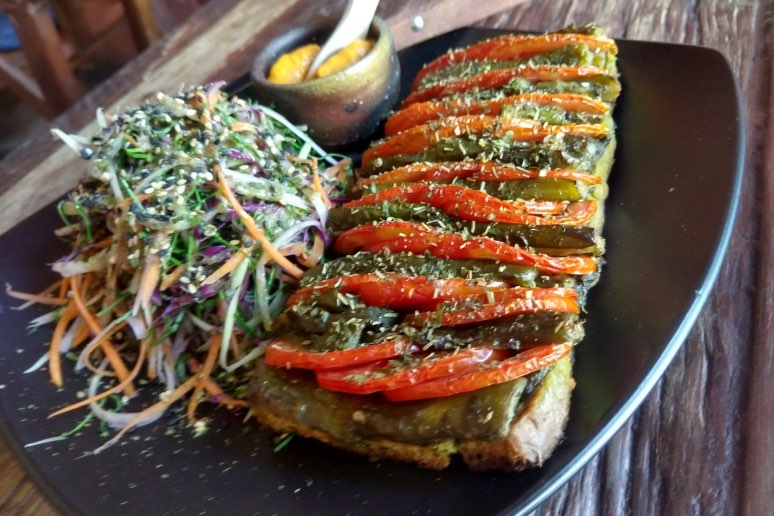
Outfit Your Kitchen
Here are the essential kitchenware items for well-stocked a vegan kitchen:
- Kitchen knives
- Cutting board
- Pots and pans
- Cooking spatulas
- Colander
- Salad spinner
- Baking sheets
- Measuring cups & spoons
- Mixing bowls
- Vegetable peeler
- Citrus reamer
- Airtight glass or plastic containers
- Can and bottle opener
Properly outfitting your kitchen costs surprisingly little. Apart from kitchen knives, which we’ll consider next, these items don’t need to cost much. Our cookware guide offers detailed buying advice.
Good Cooks Need Good Knives
No matter how tight your budget, never buy a cheap kitchen knife.
A good chef’s knife is a must for any sort of cooking. Consider your main kitchen knife a lifetime investment. The Victorinox Fibrox 10-inch chef’s knife offers workmanship comparable to restaurant grade knives costing triple the price.
Restaurant chefs sharpen their knives at least once a week. If you do a moderate amount of cooking, you can get away with twice a year. I don’t sharpen my own knives because it’s a fussy task that benefits from proper equipment. Local farmers’ markets sometimes feature a knife-sharpening stall. Alternately, you may have a knife or cutlery store in town. A sharp knife makes cooking vastly more pleasant. The moment you use your just-sharpened knife you’ll wish you’d taken it in sooner.
In addition to your main chef’s knife, also pick up a few utility knives. These smaller knives don’t cost much, and you’ll use them constantly. Finally, if you bake your own bread or buy it un-sliced, you should also purchase a bread knife. Here, you can go cheap, since serrated blades don’t need to be high quality. Oddly, bread knives are also ideal for cutting tomatoes. An inexpensive bread knife does its job nicely and lasts for years.
Appliances
Well-chosen kitchen appliances open up all sorts of food preparation possibilities. A little money spent here goes a long way. Many of the most useful appliances—such as toasters, blenders, slow cookers, and immersion mixers—cost less than a decent restaurant meal. Expensive models may look fancier but they rarely perform better or last longer.
Other appliances don’t come cheap, specifically:
- Instant Pots
- Food processors
- Bread machines
- Rice cookers
- Professional-grade blenders
- Microwave ovens
- Air fryers
Think of these appliances as an investment rather than an expense. Even pricey appliances can quickly pay for themselves by reducing your food costs. For instance, suppose you prepare a batch of hummus and and a pot of soup every week using an Instant Pot and a Blendtec blender. You can easily save more than ten dollars a week over buying these foods in packaged form. So, in less than a year, you would fully recoup your investments in both these appliances. And if you cook big batches of food for a large family, your appliances will save you even more time and money.
Dining Out
Depending on where you live, you may well have numerous exceptional local vegan dining options. Not everybody is so lucky. Some small towns have nothing but a lone Taco Bell as their only vegan-friendly restaurant. But most cities of any size have a variety of excellent choices.
Searching Google Maps for “vegan food near me” will bring up nearly everything in your area. Then check HappyCow for anything that Google might have missed.
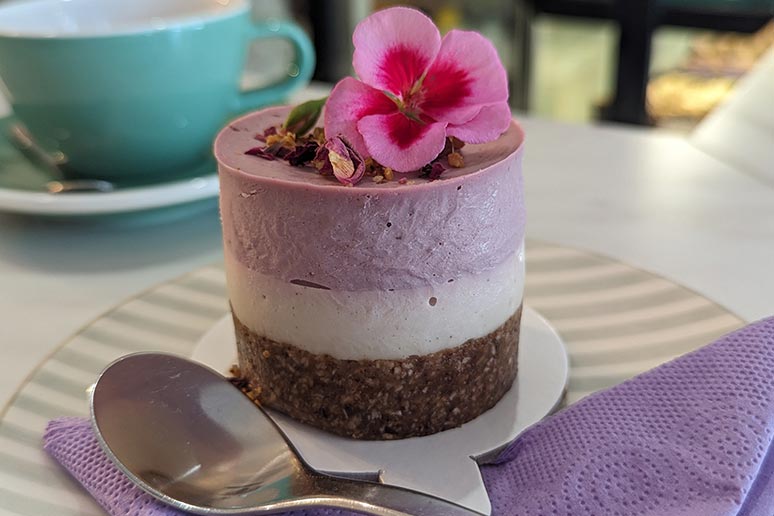
Vegan-Friendly Restaurant Food
Many of the world’s most beloved cuisines offer sensational vegan dishes:
- Middle Eastern: falafel, hummus, or baba ghanouj served in pita or wrapped in lavash
- Ethiopian: vegetable stews accompanied by injera bread
- Italian: spaghetti with marinara, green salads, cheese-free pizza
- Indian: chana masala, basmati rice, dosas, chapatti
- Mexican: burritos made with beans, rice, salsa, and guacamole
- Chinese: vegetable and tofu stir-fries over jasmine rice
When dining out at non-vegan restaurants, I regard Middle Eastern, Ethiopian, and Italian as the most reliably vegan-friendly cuisines.
Ordering at Indian restaurants requires vigilance since dairy products can show up in nearly anything. Mexican restaurants pose even greater problems since they often cook their rice in chicken stock, and they also sometimes fry their beans in lard. I therefore avoid eating at Mexican restaurants unless they make a clear effort to accommodate vegan customers.
Despite the fact that no other cuisine relies so heavily on rice and vegetables, Chinese restaurants rarely offer dependably vegan menu items. Chicken stock or eggs can hide in soups, noodles, and even mixed vegetables. Luckily, vegans who love Chinese food have a haven at PF Chang’s. This popular chain offers a separate vegetarian menu that actually features nothing but vegan food, if you look past the technicality that tiny amounts of cane sugar appear in some dishes.
For further information on eating out as a vegan, please see my guides to restaurant dining and vegan-friendly cuisines.
Vegan Fast Food
Taco Bell and Subway operate thousands of restaurants in the USA and worldwide. Both chains offer several vegan menu items. At Taco Bell, order a, “Bean Burrito, Fresco Style,” and they’ll swap out the cheese for chunky salsa.
Subway sells “Veggie Delight” sandwiches, but you must request no mayonnaise or cheese. To avoid honey, you also need to order your sandwich on white bread.
For some of the finest vegan fast food available, visit a Cal-Mex burrito restaurant like Chipotle, Qdoba, or Taco Del Mar. These chains serve higher-quality food than either Taco Bell or Subway, and they offer impressive vegan options.
Burger King and White Castle both feature the Impossible Burger. To keep your meal vegan, you must ask them to leave off the cheese. At Burger King, you’ll also have to request no mayo.
See our Guide to Vegan Fast Food for more excellent options.
Vegan Travel
One of the great joys of travel is all the delicious vegan food you will discover. You’ll encounter vegan dishes unlike anything you can get at home. No matter where you go, Google Maps, HappyCow, and Trip Advisor will help you find the best available vegan meals.
Even if you visit a place that’s generally inhospitable to vegans, you can find plenty of fruits, vegetables, pasta, and so forth at local markets. Most towns have excellent bakeries. When making short trips to challenging parts of the world, bring along some nuts and energy bars and try to rent a place with a kitchen.
Although you can eat well wherever you travel, why not plan your next vacation in one of the world’s most vegan-friendly cities? These include:
- Portland, Oregon (USA)
- Prague, Czech Republic
- London, England
- Guadalajara, Mexico
- Toronto, Canada
- Chiang Mai, Thailand
- Berlin, Germany
See our vegan travel page for additional advice.
Branching Out to a Vegan Lifestyle
When Donald Watson coined the word vegan in 1944, he defined it solely in dietary terms. But many vegans extend the concept to cover their entire lifestyle. Doing so takes little effort and makes great sense.
Animal products show up in all sorts of consumer goods. Belts, shoes, and handbags are commonly made from leather or suede. Many garments contain wool or silk fibers. And cosmetics often rely on animal testing, and may also be formulated with various animal by-products. Whenever animals are used for commercial purposes, cruelty is rarely far behind.
No matter what you need, it’s easy to choose vegan. Start by reading my articles on wool, leather, and silk so you can learn the key objections and discover vegan alternatives. For your personal care and beauty needs, I offer extensive coverage devoted to every major product category.
And finally, since many substances found in food and cosmetics are of unclear origin, my animal ingredients list will help you spot non-vegan items. Thankfully, with thousands of products now carrying vegan seals, you’ll rarely need to read the fine print.
Socializing and Finding Community
Meetup.com offers an unmatched directory of local vegan gatherings. Just type Vegan into its search box and see what pops up. You will probably find at least one regularly-held vegan dining or potluck event in your community. If your search comes up empty, consider using the Meetup platform to launch your own gathering. Hillary Rettig’s local activism guide offers a wealth of information about how to organize and promote regularly-held vegan events.
You can also meet like-minded people at big regional vegan festivals held in cities all over the world. Here’s how to find one near you.
For dating, all the leading platforms like OK Cupid, Plenty of Fish, and Match.com allow you to screen profiles by dietary preference. Also check out VeggieDate, which caters exclusively to vegetarians and vegans.
A Recap of Key Advice
This short guide covered a lot of ground. So let’s recap its key advice to ensure you didn’t miss anything crucial:
- If you’re not ready to go vegan overnight, you can speed your transition by making a lesser commitment like eating vegan before 6:00 PM, or going vegan in your kitchen.
- Take nutrition seriously. Ginny Messina’s Vegan Nutrition Guide will help you avoid the most common deficiencies that may arise when following a vegan diet.
- Get as specific as possible about which non-vegan foods you do not feel ready to quit. For instance, don’t say you’re not ready to give up cheese. Instead, name the specific type of cheese that presently has a hold over you. Getting specific in this way will enable you to identify the non-vegan foods you are ready to quit today.
- The best entry point to vegan cooking involves mastering the preparation of these easy items: sandwiches, salads, stir-fries, bowls, smoothies, and roasted vegetables.
- No matter your cooking skills, make your first vegan cookbook an easy one. Gaz Oakley’s Plants Only Kitchen is a solid choice.
- Searching your phone’s Google Maps app for “vegan restaurants” will enable you to discover the best local dining options.
- If you get hungry while traveling and can’t find any vegan restaurants nearby, order Taco Bell’s Bean Burrito “Fresco Style.” Or get Subway’s Veggie Delight on a white roll without cheese or mayo. And don’t forget that every supermarket carries plenty of vegan food.
Easy Does It
As you can see, just a little reading has put you well on your way to becoming vegan. You now know everything required to make rapid progress.
Going vegan is easy and will improve your life in so many ways. Every step matters. So just choose whichever ideas you’ve gleaned from this article that excite you most. The process of transitioning to a vegan lifestyle primarily involves crowding non-vegan foods out of your diet by finding plant-based foods that you prefer. The more unfamiliar vegan foods you sample, the quicker you will progress. So make a game of it! How many new vegan foods can you try over the next week?
Every long-term vegan will tell you that their transition went more easily than they expected. So relax and have fun—all sorts of delicious discoveries await.
For further reading: please see our “Why Go Vegan?” essay and our comprehensive vegan foods coverage.
Endnote
- Advances in printing technology have contributed to this problem. Until recently, the substantial costs involved in using offset presses to print books made publishing mediocre cookbooks too risky. Publishers had to print at least 3000 books at a time, which required a big up-front expense. The rise of low-cost “print-on-demand” technology took most of the financial risk out of book publishing. If a print-on-demand book flops, the publisher doesn’t lose much money. Print-on-demand has revolutionized book publishing, but it has dramatically lowered the quality of the average vegan cookbook. Publishers have used print-on-demand to flood the vegan cookbook market with hundreds of mediocre and hastily produced titles. Worse yet, the most popular vegan cookbooks on the market often have a crappy print-on-demand knock-off carrying the exact same title.

